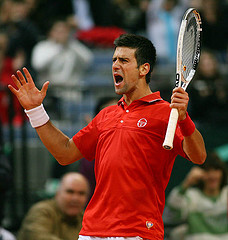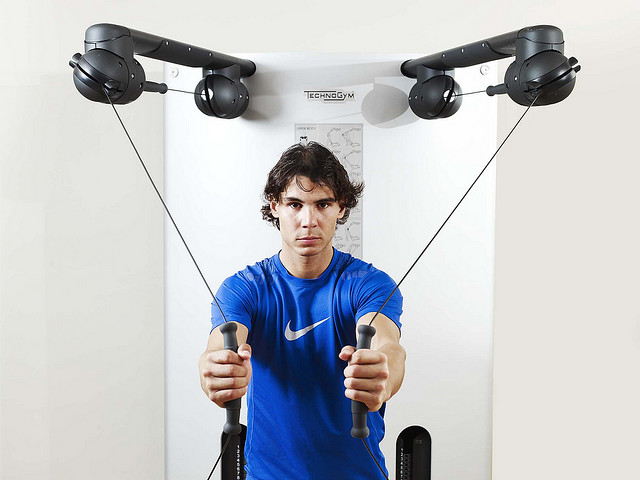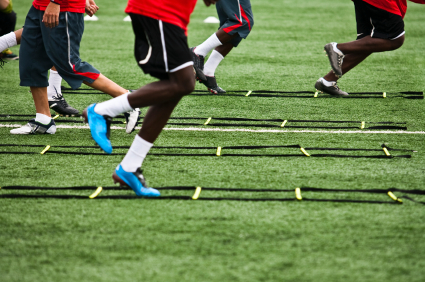Most of the time, highly specific tennis conditioning drills are only done by professional players or those at the collegiate level of tennis. The fact that these specific drills for tennis fitness are only done by the best players are a sign that players that want to start winning tennis matches should consider adding this element on their tennis training.
Most tennis conditioning drills are not fun nor easy, but it’s purpose is beneficial in the long run. In fact, tennis drills for conditioning force the body close to it’s limits preparing the mind and body for the rigors of a competitive tennis match.
Tennis technique, strokes and strategy are only half of the equation needed to be a world class tennis player. The other half is physical tennis fitness, which can be improved upon through tennis conditioning drills.
Tennis Conditioning Drills at the Pro Level


In March of 2011, Novak Djokovic, the gifted Serbian player best known for his impersonations of his fellow tennis stars, played the world’s number one player Rafael Nadal in Miami at a tournament known as the “fifth grand slam.”
They split the first two sets and went toe to toe in the third, running all over the court in long rallies, chasing after each other’s most aggressive shots in a spectacular show of one-upmanship.
They went to a tiebreaker, where, inevitably, one had to win and one had to lose. The loser just ran out of gas a bit earlier than the other. And to everyone’s surprise, the loser was Nadal.
How could the world’s fittest and strongest player, a person who had been described as a physical freak of nature, get tired before Djokovic – a player who had a long history of withdrawals due to fatigue and injury?
When asked afterward what his secret was, Djokovic was coy, saying only that he had improved his fitness. But to the keen observer, it was clear that he had upgraded his whole training. He had identified, after a few years of trial and error, what specific set of tennis conditioning drills he needed to incorporate into his training. And in doing so, he had become the winner he always knew he could be.
The examples set by the top pros are something every ordinary player can follow. Whether you are a beginner, a college varsity player, a veteran club player or a weekend hacker, the benefits of doing tennis conditioning drills are always applicable. If you want to win more matches, getting fitter and faster is one way to doing it.
Tennis Conditioning Drills Help The Rest Of Your Game
There are some players who don’t have the best strokes or seem to have such an incomplete set of skills that you wonder how they will ever win any match. But if they are fit and fast, they can outrun and outlast their opponents and end up winning most of the time.
These players understand that tennis is not just a game of skill but also an athletic endeavor which requires an optimum level of fitness in order to perform at maximum potential. That being said, the main components of a setting up a program of tennis conditioning drills should include exercises that enhance a player’s strength, flexibility, speed, coordination, reaction time and stamina.
Improving one’s strength is valuable because it assists in developing the other aspects of overall fitness, especially speed. The modern game has become more power-oriented due to the high tech rackets and strings. In order to hit harder, a player has to get stronger. Proper technique is actually more important for this but at the same time; good strokes are also easier to learn if a player has a good base of physical strength upon which to develop these.
Strengthening the Core Body With Tennis Conditioning Drills


In tennis, the core muscles are the most important ones to strengthen if you want to develop more powerful strokes. When people hear core, they immediately think abdominals. It’s true that these are very important and need to be incorporated into any set of tennis conditioning drills.
These include sit ups, leg raises and exercises that develop the obliques for twisting the trunk. But there is another area that needs just as much attention – the back.
A very good exercise for the back, among many, is the so called Superman exercise.
The person lies flat on his or her stomach and raises his hands and legs off the floor, holding for 5-10 seconds. Repetitions are done depending on his or her fitness level. A close partner of core strength is core flexibility. The trunk has to be limber enough to twist and turn accordingly with each stroke. Accordingly, stretches that involve side, back and front bends along with trunk twists should be part of any set of tennis conditioning drills.
Tennis Conditioning Drills: Shoulders


Concomitantly, the shoulders also need to be flexible. Stiff shoulders hamper the serve and overhead shots, as well as the groundstrokes. Stretching the shoulders regularly should also be included in the program of tennis conditioning drills.
Tennis Conditioning Drills: Wrists & Elbow
The arms are the most obvious body parts that should be strengthened for tennis. In particular, the wrists and elbow joints are prone to injury, especially with today’s more whippy strokes. Exercises that strengthen these joints are important and these include bicep and tricep exercises and wrist curls.
The muscles for wrist pronation and supination also need strengthening. This will help with developing a stronger serve and firmer volleys. Just like the shoulder, wrist flexibility is just as important, so these should be stretched properly as well
Tennis Conditioning Drills: Speed Drills


Speed is just as important, if not more so than strength. But in talking about the tennis conditioning drills for the lower body, strength training and speed training go hand in hand. You need to have strong legs in order to develop explosive leg power, which is how one develops more speed.
Exercises for the legs include squats, lunges and calf raises. The hips are also important, so different exercises for this area like leg raises (forward, sideward and backward) are all necessary. Like all other body parts, the legs and hips also need to be flexible.
You don’t necessarily need to be able to do a split but the hamstrings, quads, adductors, abductors and calves all need to be stretched and kept limber. Real speed training is another special set of exercises that need to be included as conditioning drills for tennis. These include shuttle runs, sprints and lateral movement drills.
Tennis Conditioning Drills: Reaction Time
Coordination and reaction time can be improved through drills like medicine ball tossing, ball catching and quick volley drills. Expectedly, these are more easily improved if there is a base of strength, speed and flexibility in place for the player already. Constant repetition of these drills is the only way to ensure that these skills do not erode over time.
Tennis Conditioning Drills: Stamina & Endurance
The last aspect of tennis conditioning drills involves improving one’s stamina. There is no secret or short cut here. Aerobic exercises like running, swimming, cycling and cross-country skiing are recommended. A player should gradually start with just the right amount of aerobic exercise to raise his or her heart rate to its target heart rate.
If that means swimming only one lap at moderate speed, then that’s what he should start with. Additional laps can be added accordingly as his or her fitness and stamina improve. Stamina is so important in tennis because a best of three set match may last less than an hour if it is a straight set blowout or go for more than three hours if both players are really evenly matched. Each player needs to come to the court knowing that anything is possible and be ready for it.
Tennis Conditioning Drills: The Purpose
Most people try to take up sports because they think it is a fun way of getting fit. But if they get into a sport like tennis without first working on their fitness, they might just end up getting injured and unable to enjoy themselves. It makes more sense to improve one’s fitness in order to play a sport.
That way, they can learn quicker and have more fun in the process. Remember to always consult with a physician and a certified trainer before starting any physical fitness program. Lastly, be patient with your progress. Novak Djokovic already had a full team of coaches and trainers to help him get proper conditioning but it still took him a few years before he was able to he was able to win as many matches as he has been doing now. He always knew he could be a dominant player and he was patient with himself. You should too.
Learn to Hit a Forehand Like Roger Federer
If you want to jumpstart your forehand and play like the PROS, check out my 70+ page Tennis Ebook that will immediately show you how you can take your forehand to the next level.
The Modern Forehand Domination Ebook is guaranteed to improve your tennis technique, and increase power, topspin and accuracy of your tennis forehand!
Modern Tennis Forehand Ebook
Learn How to Hit a Forehand Like Federer, Nadal and Djokovic

